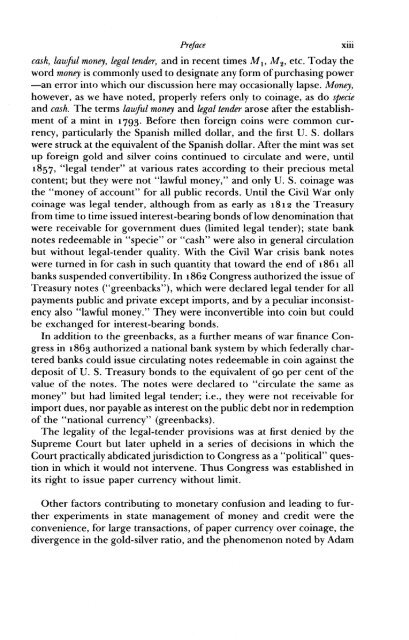Create successful ePaper yourself
Turn your PDF publications into a flip-book with our unique Google optimized e-Paper software.
Preface XIU<br />
cash, lawful money, legal tender, and in recent times M l' M 2' etc. Today the<br />
word money is commonly used to designate any form ofpurchasing power<br />
-an error into which our discussion here may occasionally lapse. <strong>Money</strong>,<br />
however, as we have noted, properly refers only to coinage, as do specie<br />
and cash. The terms lawful money and legal tender arose after the establishment<br />
of a mint in 1793. Before then foreign coins were common currency,<br />
particularly the Spanish milled dollar, and the first U. S. dollars<br />
were struck at the equivalent ofthe Spanish dollar. After the mint was set<br />
up foreign gold and silver coins continued to circulate and were, until<br />
1857, "legal tender" at various rates according to their precious metal<br />
content; but they were not "lawful money," and only U. S. coinage was<br />
the "money of account" for all public records. Until the Civil War only<br />
coinage was legal tender, although from as early as 1812 the Treasury<br />
from time to time issued interest-bearing bonds oflow denomination that<br />
were receivable for government dues (limited legal tender); state bank<br />
notes redeemable in "specie" or "cash" were also in general circulation<br />
but without legal-tender quality. With the Civil War crisis bank notes<br />
were turned in for cash in such quantity that toward the end of 1861 all<br />
banks suspended convertibility. In 1862 Congress authorized the issue of<br />
Treasury notes ("greenbacks"), which were declared legal tender for all<br />
payments public and private except imports, and by a peculiar inconsistency<br />
also "lawful money." They were inconvertible into coin but could<br />
be exchanged for interest-bearing bonds.<br />
In addition to the greenbacks, as a further means of war finance Congress<br />
in 1863 authorized a national bank system by which federally chartered<br />
banks could issue circulating notes redeemable in coin against the<br />
deposit of U. S. Treasury bonds to the equivalent of 90 per cent of the<br />
value of the notes. The notes were declared to "circulate the same as<br />
money" but had limited legal tender; i.e., they were not receivable for<br />
import dues, nor payable as interest on the public debt nor in redemption<br />
of the "national currency" (greenbacks).<br />
The legality of the legal-tender provisions was at first denied by the<br />
Supreme Court but later upheld in a series of decisions in which the<br />
Court practically abdicatedjurisdiction to Congress as a "political" question<br />
in which it would not intervene. Thus Congress was established in<br />
its right to issue·paper· currency without limit.<br />
Other factors contributing to monetary confusion and leading to further<br />
experiments in state management of money and credit were the<br />
convenience, for large transactions, ofpaper currency over coinage, the<br />
divergence in the gold-silver ratio, and the phenomenon noted by Adam

















